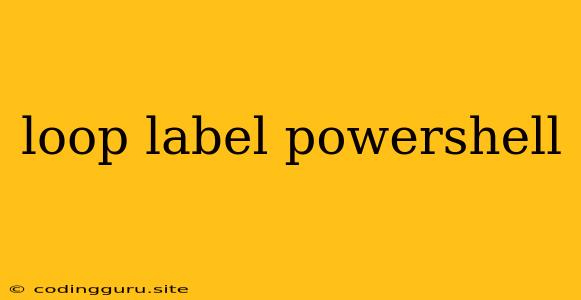Understanding and Using Loop Labels in PowerShell
PowerShell is a powerful scripting language that provides a wide range of tools for managing and automating systems. One of the key features of PowerShell is its support for loops, which allow you to repeat a block of code multiple times. While PowerShell offers various loop structures like for, foreach, and while loops, there are scenarios where you might need more control over the flow of these loops. This is where loop labels come into play.
What are Loop Labels?
Loop labels in PowerShell provide a way to identify and reference specific loops within your script. They are essentially names assigned to loops that allow you to manipulate their execution behavior, especially in nested loop scenarios.
Why Use Loop Labels?
-
Controlling Nested Loops: Imagine you have multiple nested loops, and you want to exit the outer loop when a certain condition is met within the inner loop. Using a loop label allows you to directly break or continue the specific loop you want to control.
-
Breaking Out of Loops: Sometimes, you might need to prematurely exit a loop based on a condition that occurs within the loop. Loop labels make it easier to break out of the correct loop, especially in complex scenarios involving nested loops.
-
Enhanced Script Readability: By assigning meaningful labels to your loops, you improve the readability of your script, making it easier to understand the flow of your code, especially in complex scripts.
How to Use Loop Labels in PowerShell
- Assigning Labels: To label a loop, simply place a name followed by a colon before the loop statement. For example:
OuterLoop:
foreach ($item in $items) {
# Loop code here
}
-
Using
breakandcontinue: You can use thebreakandcontinuekeywords in conjunction with loop labels to manipulate the loop's execution.break: Exits the labeled loop immediately.continue: Skips the current iteration of the labeled loop and proceeds to the next iteration.
-
Example:
OuterLoop:
foreach ($i in 1..5) {
InnerLoop:
foreach ($j in 1..3) {
if ($i -eq 3 -and $j -eq 2) {
break OuterLoop;
}
Write-Host "i = $i, j = $j"
}
}
In this example, the outer loop (OuterLoop) iterates from 1 to 5. The inner loop (InnerLoop) iterates from 1 to 3. When $i equals 3 and $j equals 2, the break OuterLoop statement is executed, causing the script to exit the outer loop immediately.
Conclusion
Loop labels in PowerShell offer a powerful way to control the flow of your scripts, especially in nested loops. By understanding their use cases and syntax, you can write more efficient and readable PowerShell scripts for managing and automating your tasks. Remember to use labels judiciously and choose meaningful names to enhance the clarity of your code.
